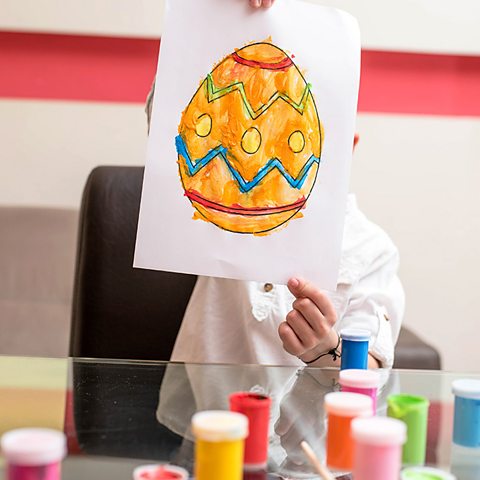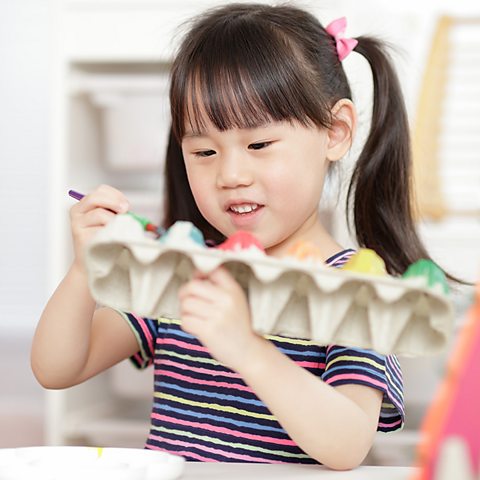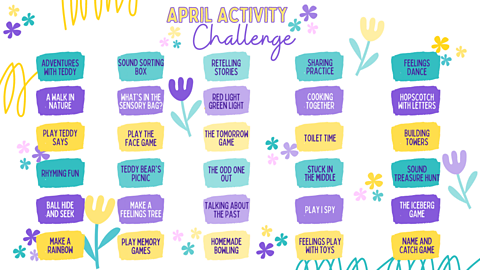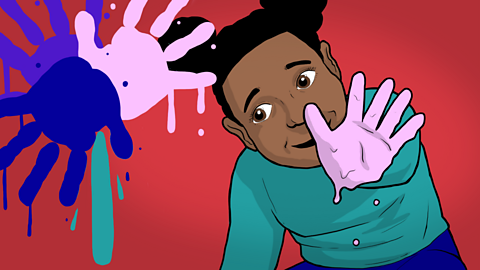Easter is a perfect time to get together with friends and family, enjoy the longer days and have fun with your young children.
Below weтАЩve listed some of our favourite language-learning activities that will keep your child entertained for the whole weekend. You wonтАЩt need anything other than a few household items and some eggs.

1. Easter egg treasure hunt
Whether in your garden, on your balcony or around the house, a treasure hunt is a sure-fire way to get everyone excited on Easter Sunday.
You donтАЩt need to use chocolate eggs if you donтАЩt have enough, any set of items will work fine. Your child will enjoy the process of finding them just as much.
Searching for objects engages your childтАЩs thinking and concentration skills, and giving them clues helps them understand longer sentences.
You can adapt your clues based on your childтАЩs age. When they are younger, you could say тАЬsomething is hiding under the tableтАЭ or тАЬnext to the sofaтАЭ. This helps them learn all about descriptions of place.
As they get older, you could use тАЬcolderтАЭ and тАЬwarmerтАЭ clues to help them find the objects and let them count to ten before searching.Once theyтАЩve found an item, give them plenty of encouragementтАжand maybe a little Easter treat?

2. Draw and colour in Easter eggsтАж
Drawing together is a great activity to get your child talking. Why not print off or draw an egg outline on some blank paper and have a colouring-in session?
Colouring not only helps develop your child's motor skills but also encourages creativity. Ask them lots of questions about what colours they are using and how they are decorating their eggs.
If youтАЩve got people visiting for the holidays, you could try and colour in an Easter egg for each of them.
Colouring is a great activity for focussing the brain, so you could always turn Easter colouring into a pre-bedtime routine in the week running up to the big day.
ItтАЩs also a perfect activity for Easter itself, calming your children down after the excitement of sugar and treasure hunts.
3. тАжcut them in half for a pairing game
Matching games are a fun way to help develop your child's language, concentration and memory skills.
By cutting your ready-made Easter egg pictures in half, you can create a fun pairing game that is great for children of all abilities.
Start by laying out the Easter egg halves facing upwards on a flat surface. Ask your child which Easter eggs have the same colours. Can they put them together without your help?
As they grow, your child might be able to turn the pieces face down and play a more traditional pairing game - revealing just two halves at a time.
Being able to match items and explain why they go together is important for cognitive development, which can help with reading and recognising letter sounds later on.


4. Decorate eggsтАж
When it comes to fun Easter activities, decorating hard-boiled eggs is an easy win.
ItтАЩs great for letting your child express their artistic side but also can improve fine motor skills and hand-eye coordination.
You donтАЩt need to use paintbrushes, just let your child dip their fingers in the paint and get creative. Ask your child to describe the colours and shapes they are painting. You could ask if the paint feels 'sticky' or 'slippery'.
While you shouldnтАЩt be afraid of getting messy, if you are looking for something a little tidier than paint or dyes, there are plenty of alternative options.
You could try:
- Using coloured pens to create a fun design
- Sticking on bits of paper with tape or glue
- Using items found on a nature walk to decorate your eggs
5. тАжor an egg box
If you are decorating eggs for your Easter celebrations, then donтАЩt forget about the boxes they came in.
From creating a pretty egg holder to turning the box into something completely different like a car or a frog - there is no limit to the creations you could make with this simple piece of cardboard.
Let your child take the lead and decide what they want to create. Ask them to describe their creation and what they are doing at each step. This helps to form longer sentences and also develops their problem-solving skills.
Art and craft activities are packed with sensory experiences to inspire your little one, which makes them perfect for any time of the year - not just Easter.


6. Have an egg rolling race
Choose a starting and finishing line, put down your eggs (if youтАЩre feeling brave you could use a decorated one) and countdown to go. Who can roll their egg the fastest and cross the finish line first?
This is a great game to play with the whole family and can be played outside, inside or at the park. Just make sure there is enough space for everyone to overtake one another.
You can get creative in choosing how to roll the egg. Perhaps in one race, you can only roll it with your foot, and in another, you can use sticks or twigs you have found around in the park.
Let your child make the rules to unleash their creativity and build their confidence. Talk about what they have to do and make sure they understand.
This is a great activity for getting rid of any excess Easter energy.
7. Play whatтАЩs in the egg box
This is our Easter take on our тАШWhatтАЩs in the Bag?тАЩ game.
Hide a small toy or object inside an egg box. Be careful to choose things big enough for your baby not to choke on them. You could use things like a small spoon, a toy car, a ball, or a balled-up baby sock.
Say the words тАШReady, steadyтАж goтАЩ before you open the box together. This builds up anticipation and gets your child interested.
Let them explore what is hidden in the box. Describe and name the item to your child to help them learn the words.
If your child is a little older, see if they can guess what is in the box before you open it. Use open questions and encourage lots of descriptive vocabulary.


In case you missed it
Clicking on each activity will take you directly to the right page on our website.





